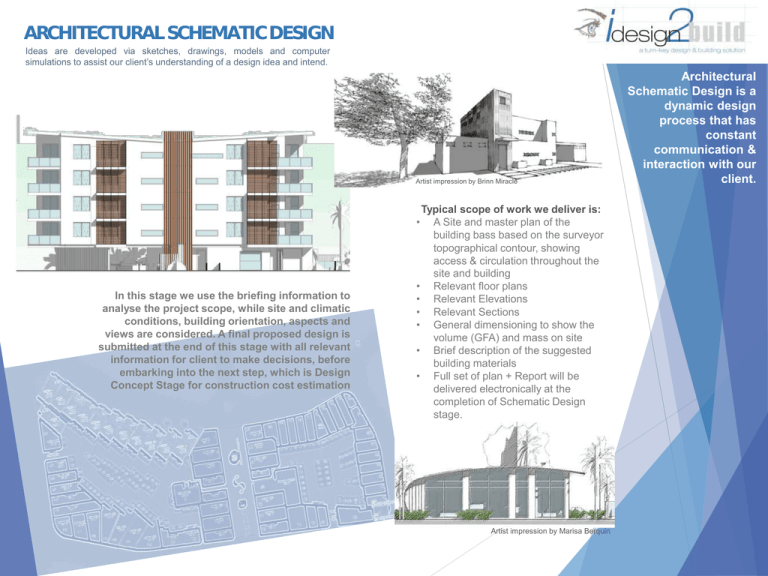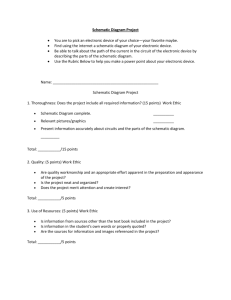Schematic Design - i Design 2 Build
advertisement

ARCHITECTURAL SCHEMATIC DESIGN Ideas are developed via sketches, drawings, models and computer simulations to assist our client’s understanding of a design idea and intend. Artist impression by Brinn Miracle In this stage we use the briefing information to analyse the project scope, while site and climatic conditions, building orientation, aspects and views are considered. A final proposed design is submitted at the end of this stage with all relevant information for client to make decisions, before embarking into the next step, which is Design Concept Stage for construction cost estimation Typical scope of work we deliver is: • A Site and master plan of the building bass based on the surveyor topographical contour, showing access & circulation throughout the site and building • Relevant floor plans • Relevant Elevations • Relevant Sections • General dimensioning to show the volume (GFA) and mass on site • Brief description of the suggested building materials • Full set of plan + Report will be delivered electronically at the completion of Schematic Design stage. Artist impression by Marisa Berquin Architectural Schematic Design is a dynamic design process that has constant communication & interaction with our client. ARCHITECTURAL SCHEMATIC DESIGN Ideas are developed via sketches, drawings, models and computer simulations to assist our client’s understanding of a design idea and intend. Schematic Design – The Basics The designer compiles all of the required and desired elements into a set of conceptual sketches. As the word ‘schematic’ would suggest, these conceptual sketches aim to show the relationship between parts in an informal and loose manner. The schematic drawings may include a number of different iterations or schemes, each having a unique feature or focus. For example, schematic design concepts for an office building may show one option that features windows oriented towards sweeping views while another concept depicts windows arranged for maximum solar efficiency. Each schematic sketch or drawing will respond in some way to the list of programmed spaces, the qualitative goals, and the site on which it will be located. During the schematic design phase, many ideas will be brought up, discussed, reviewed and refined. It may take several attempts before arriving at a particular concept which seems to best embody all of the goals and requirements. Throughout the schematic design phase, the needs and goals of the client will be reevaluated in connection with how they will best develop into real spaces. Sometimes program requirements or goals are in conflict with what is spatially feasible, and may require some adjusting. It may even be to re-draft the program after making a first pass at schematic design to ensure necessary that expectations are clearly stated based on any new design criteria discovered in schematic design. Multi-residential Units Floor plan Schematic design is the stage that is often the most exciting for clients. They can begin to see sketches and quick physical models of their dreams coming to life. Sometimes, clients will be inspired by the designs presented to them and consider increasing their project scope. While some schematic designs may indicate a change in scope is necessary, it is always important to refer back to the original program to ensure the project stays within the guidelines of needs, goals and budget requirements. As the project is visualized through sketches, models and inspiration images, clients can quickly get an idea of how their building will start to look. Schematic Design – Digging Deeper Schematic designs consist of floor plans, simple elevations, quick 3D views and conceptual rough sections. Floor plans will be drawn to scale and may include suggested interior arrangements. The drawings will indicate the general location of openings (windows, doors) in addition to any big ideas the concept was based on. Accompanying drawings which help the client visualize the main features and really ‘sell’ the concept will be included as well. As example, if a driving concept for a house was to provide abundant natural light, the schematic design would clearly indicate the window placement and possibly include perspective drawings of the windows, doors and any key views. 3D Mass models are the best way to understand the relationship of volumes in the vertical plane, similar to the way that floor plans help us understand the relationship of rooms in the horizontal plane. A mass model that shows a two-storey living room may be constructed as a tall box with a triangle roof, which could indicate a lofted ceiling underneath. Architectural Schematic Design work samples


